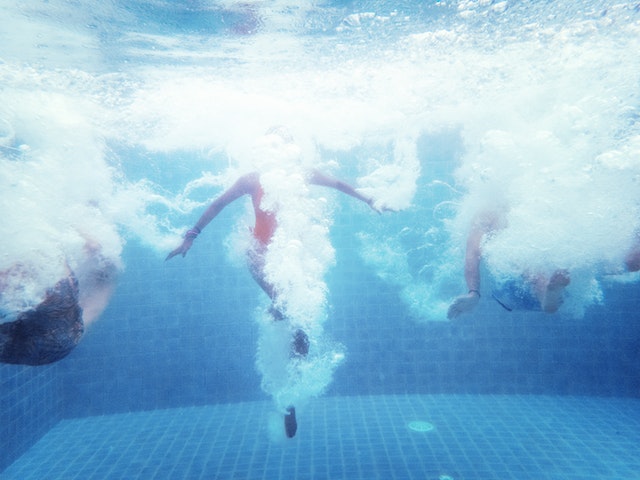
While swimming pools can be an excellent reprieve from the sweltering summer heat, they also present serious injury risks that can spoil the fun. Drowning may be the leading cause of swimming pool injuries. However, there are other situations that can occur in a swimming pool that can risk injuring people of all ages.
In order to keep you and your family safe this summer, I want to take a moment to warn you about 3 non-drowning causes of swimming pool injuries.
If you or a loved one suffers a severe swimming pool injury, you can request a free consultation through our contact form or call the Thomas Creech Law Offices at 864-235-4999 by tapping the button below.
1. Swimming Pool Injuries: Entrapment
Body entrapment
What happens: An expansive part of the body, generally the torso or backside, completely covers the outlet, causing a vacuum to form and the skin to adhere to the drain.
Number of incidents: From 1999 – 2009, there were 33 recorded body entrapments.
The issue: Single-drain pools and spas can pose a danger that many swimmers, especially children, are not aware exists.
Prevention: The only way to completely eliminate the hazard is to disable the drain or build a drain-less system. However, the risk can be greatly reduced by installing VGBA-approved outlet covers, multiple-drain systems, secondary devices or gravity-feed systems.
Limb Entrapment
What happens: A broken or missing drain exposes the outlet and a swimmer’s limb becomes entrapped in the pipe.
Number of incidents: From 1999 – 2009, there were 32 recorded limb entrapments.
The issue: Children, or even adults, may insert an arm into an exposed drain.
Prevention: Install VGBA-certified drain covers and make sure they remain secure. Even more effective: Build a pool with no submerged suction outlets of any kind.
Hair entrapment
What happens: Hair entrapment is the result of hair getting stuck in the drain and wrapping around components.
Number of incidents: From 1999 – 2009, there were 13 recorded hair entrapments.
The issue: Strands of hair are tiny, allowing them easy access through the grate.
Prevention: After drain-less systems, the most effective preventive measure is the use of certified outlet covers with a flow rating higher than the maximum pump flow.
Evisceration
What happens: When the backside completely covers the drain, and there is no system in place to prevent a vacuum, the force can cause a tear in the tissue and the intestines begin exiting the body.
Number of incidents: From 1999 – 2009, there were two recorded eviscerations.
The issue: Eviscerations happen very rapidly, making them more difficult to curtail once the process has begun.
Prevention: Install a drain-less system or VGBA-certified drain covers. Multiple outlets and gravity-feed systems are believed to mitigate the problem; however, this has not been proven.
Mechanical entrapment
What happens: An object, such as a chain or bathing-suit strap, catches on a drain, wraps around a component or otherwise becomes lodged.
Number of incidents: From 1999 – 2009, there were 13 recorded mechanical entrapments.
The issue: Like hair entrapment, this is not caused by suction, but involves a mechanical attachment, which must be broken for the person to become freed.
Prevention: Install drain-less systems or VGBA-certified outlet covers.
All of these types of entrapment often lead to drowning or serious injury. Although in the United States, it is federal law for every public pool to have an anti-entrapment drain cover, private pools are unregulated. Yet, a backyard pool poses just as much danger as a public pool when it comes to entrapment. Pools with single main drains are far more dangerous than those with dual drains.
2. Swimming Pool Injuries: Electricity
Electricty and water are usually a lethal combination. However, many swimming pools have lights and other electical connections that when left unchecked can cause cause severe swimming pool injuries.
A pool light needs to be regularly maintained. Old pool lights have been known to cause electrical accidents for swimmers. Electricity used to run pumps and heaters also need to be maintained properly. Additionally, pool equipment should be supplied by ground fault circuit interrupters (GFCIs). If you’re using cord-and-plug connected devices such as radios and fans around the pool area, use a portable GFCI or plug them into a GFCI-protected circuit. Keep all devices far away enough from the pool’s edge so that they are not accessible from the water.
3. Swimming Pool Injuries: Chemical Exposure
The chemicals used to keep pools clean and safe can be dangerously toxic in high amounts. One of the most commonly used chemicals is chlorine. Chlorine is popular because it handles the three main jobs in keeping a swimming pool clean: It sanitizes (kills bacteria and germs), oxidizes (controls organic debris from perspiration and body oils), and deters algae. Chlorine, however, can dry and irritate skin as well as aggravate asthma.
Additionally, chlorine is unpopular because it has a strong odor, reddens eyes, causes allergic reactions in some swimmers, and is a known carcinogen. Chlorine absorbs into your skin. Too much exposure to chlorine has been linked to major health problems including reproductive disorders and even birth defects.
These chemicals can also kill the body’s naturally beneficial bacteria if water is swallowed, potentially causing digestive problems and lowered immunity.
Tips for avoiding chemical contamination:
- Keep chemical treatments at the proper level.
- Do not increase chemical treatments to compensate for a dirty pool.
- Follow instructions carefully when treating a pool.
- Keep pool chemicals properly stored and out of reach of children to avoid accidental poisonings.
- Store chemicals in a cool, dry place to avoid landscape contamination or risk of fire.
Wrap Up
These are just a few examples of severe swimming pool injuries that can occur. Our firm is ready to represent families in these types of cases and will be happy to discuss your case with you. Fill out the form below to request your free consultation today!
[contact-form-7 id=”3838″ title=”Contact Us”]

